José G. C. de Souza
Findings of the WMT 2024 Shared Task on Chat Translation
Oct 15, 2024



Abstract:This paper presents the findings from the third edition of the Chat Translation Shared Task. As with previous editions, the task involved translating bilingual customer support conversations, specifically focusing on the impact of conversation context in translation quality and evaluation. We also include two new language pairs: English-Korean and English-Dutch, in addition to the set of language pairs from previous editions: English-German, English-French, and English-Brazilian Portuguese. We received 22 primary submissions and 32 contrastive submissions from eight teams, with each language pair having participation from at least three teams. We evaluated the systems comprehensively using both automatic metrics and human judgments via a direct assessment framework. The official rankings for each language pair were determined based on human evaluation scores, considering performance in both translation directions--agent and customer. Our analysis shows that while the systems excelled at translating individual turns, there is room for improvement in overall conversation-level translation quality.
Modeling User Preferences with Automatic Metrics: Creating a High-Quality Preference Dataset for Machine Translation
Oct 10, 2024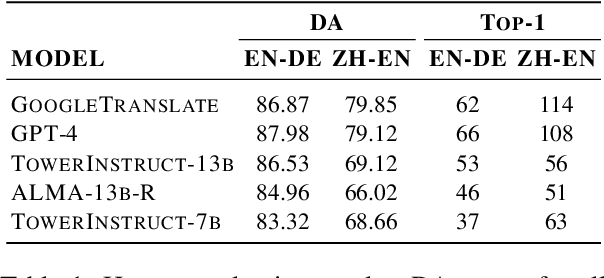

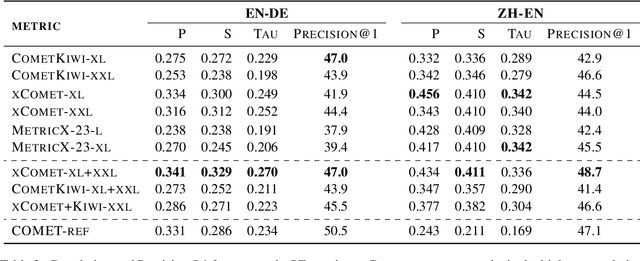

Abstract:Alignment with human preferences is an important step in developing accurate and safe large language models. This is no exception in machine translation (MT), where better handling of language nuances and context-specific variations leads to improved quality. However, preference data based on human feedback can be very expensive to obtain and curate at a large scale. Automatic metrics, on the other hand, can induce preferences, but they might not match human expectations perfectly. In this paper, we propose an approach that leverages the best of both worlds. We first collect sentence-level quality assessments from professional linguists on translations generated by multiple high-quality MT systems and evaluate the ability of current automatic metrics to recover these preferences. We then use this analysis to curate a new dataset, MT-Pref (metric induced translation preference) dataset, which comprises 18k instances covering 18 language directions, using texts sourced from multiple domains post-2022. We show that aligning TOWER models on MT-Pref significantly improves translation quality on WMT23 and FLORES benchmarks.
EuroLLM: Multilingual Language Models for Europe
Sep 24, 2024Abstract:The quality of open-weight LLMs has seen significant improvement, yet they remain predominantly focused on English. In this paper, we introduce the EuroLLM project, aimed at developing a suite of open-weight multilingual LLMs capable of understanding and generating text in all official European Union languages, as well as several additional relevant languages. We outline the progress made to date, detailing our data collection and filtering process, the development of scaling laws, the creation of our multilingual tokenizer, and the data mix and modeling configurations. Additionally, we release our initial models: EuroLLM-1.7B and EuroLLM-1.7B-Instruct and report their performance on multilingual general benchmarks and machine translation.
QUEST: Quality-Aware Metropolis-Hastings Sampling for Machine Translation
May 28, 2024Abstract:An important challenge in machine translation (MT) is to generate high-quality and diverse translations. Prior work has shown that the estimated likelihood from the MT model correlates poorly with translation quality. In contrast, quality evaluation metrics (such as COMET or BLEURT) exhibit high correlations with human judgments, which has motivated their use as rerankers (such as quality-aware and minimum Bayes risk decoding). However, relying on a single translation with high estimated quality increases the chances of "gaming the metric''. In this paper, we address the problem of sampling a set of high-quality and diverse translations. We provide a simple and effective way to avoid over-reliance on noisy quality estimates by using them as the energy function of a Gibbs distribution. Instead of looking for a mode in the distribution, we generate multiple samples from high-density areas through the Metropolis-Hastings algorithm, a simple Markov chain Monte Carlo approach. The results show that our proposed method leads to high-quality and diverse outputs across multiple language pairs (English$\leftrightarrow${German, Russian}) with two strong decoder-only LLMs (Alma-7b, Tower-7b).
Tower: An Open Multilingual Large Language Model for Translation-Related Tasks
Feb 27, 2024



Abstract:While general-purpose large language models (LLMs) demonstrate proficiency on multiple tasks within the domain of translation, approaches based on open LLMs are competitive only when specializing on a single task. In this paper, we propose a recipe for tailoring LLMs to multiple tasks present in translation workflows. We perform continued pretraining on a multilingual mixture of monolingual and parallel data, creating TowerBase, followed by finetuning on instructions relevant for translation processes, creating TowerInstruct. Our final model surpasses open alternatives on several tasks relevant to translation workflows and is competitive with general-purpose closed LLMs. To facilitate future research, we release the Tower models, our specialization dataset, an evaluation framework for LLMs focusing on the translation ecosystem, and a collection of model generations, including ours, on our benchmark.
Steering Large Language Models for Machine Translation with Finetuning and In-Context Learning
Oct 20, 2023Abstract:Large language models (LLMs) are a promising avenue for machine translation (MT). However, current LLM-based MT systems are brittle: their effectiveness highly depends on the choice of few-shot examples and they often require extra post-processing due to overgeneration. Alternatives such as finetuning on translation instructions are computationally expensive and may weaken in-context learning capabilities, due to overspecialization. In this paper, we provide a closer look at this problem. We start by showing that adapter-based finetuning with LoRA matches the performance of traditional finetuning while reducing the number of training parameters by a factor of 50. This method also outperforms few-shot prompting and eliminates the need for post-processing or in-context examples. However, we show that finetuning generally degrades few-shot performance, hindering adaptation capabilities. Finally, to obtain the best of both worlds, we propose a simple approach that incorporates few-shot examples during finetuning. Experiments on 10 language pairs show that our proposed approach recovers the original few-shot capabilities while keeping the added benefits of finetuning.
An Empirical Study of Translation Hypothesis Ensembling with Large Language Models
Oct 17, 2023



Abstract:Large language models (LLMs) are becoming a one-fits-many solution, but they sometimes hallucinate or produce unreliable output. In this paper, we investigate how hypothesis ensembling can improve the quality of the generated text for the specific problem of LLM-based machine translation. We experiment with several techniques for ensembling hypotheses produced by LLMs such as ChatGPT, LLaMA, and Alpaca. We provide a comprehensive study along multiple dimensions, including the method to generate hypotheses (multiple prompts, temperature-based sampling, and beam search) and the strategy to produce the final translation (instruction-based, quality-based reranking, and minimum Bayes risk (MBR) decoding). Our results show that MBR decoding is a very effective method, that translation quality can be improved using a small number of samples, and that instruction tuning has a strong impact on the relation between the diversity of the hypotheses and the sampling temperature.
Scaling up COMETKIWI: Unbabel-IST 2023 Submission for the Quality Estimation Shared Task
Sep 21, 2023Abstract:We present the joint contribution of Unbabel and Instituto Superior T\'ecnico to the WMT 2023 Shared Task on Quality Estimation (QE). Our team participated on all tasks: sentence- and word-level quality prediction (task 1) and fine-grained error span detection (task 2). For all tasks, we build on the COMETKIWI-22 model (Rei et al., 2022b). Our multilingual approaches are ranked first for all tasks, reaching state-of-the-art performance for quality estimation at word-, span- and sentence-level granularity. Compared to the previous state-of-the-art COMETKIWI-22, we show large improvements in correlation with human judgements (up to 10 Spearman points). Moreover, we surpass the second-best multilingual submission to the shared-task with up to 3.8 absolute points.
Bridging the Gap: A Survey on Integrating Feedback for Natural Language Generation
May 01, 2023


Abstract:Many recent advances in natural language generation have been fueled by training large language models on internet-scale data. However, this paradigm can lead to models that generate toxic, inaccurate, and unhelpful content, and automatic evaluation metrics often fail to identify these behaviors. As models become more capable, human feedback is an invaluable signal for evaluating and improving models. This survey aims to provide an overview of the recent research that has leveraged human feedback to improve natural language generation. First, we introduce an encompassing formalization of feedback, and identify and organize existing research into a taxonomy following this formalization. Next, we discuss how feedback can be described by its format and objective, and cover the two approaches proposed to use feedback (either for training or decoding): directly using the feedback or training feedback models. We also discuss existing datasets for human-feedback data collection, and concerns surrounding feedback collection. Finally, we provide an overview of the nascent field of AI feedback, which exploits large language models to make judgments based on a set of principles and minimize the need for human intervention.
CometKiwi: IST-Unbabel 2022 Submission for the Quality Estimation Shared Task
Sep 13, 2022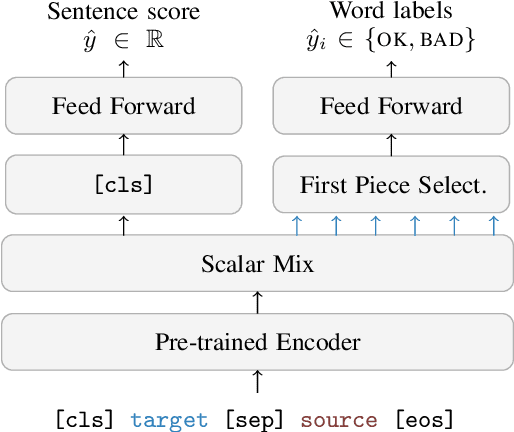
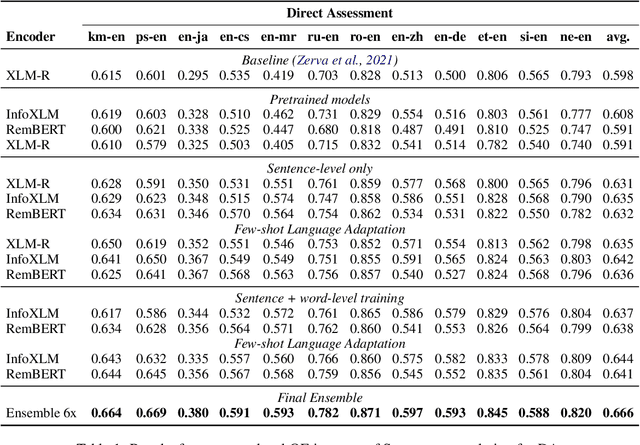
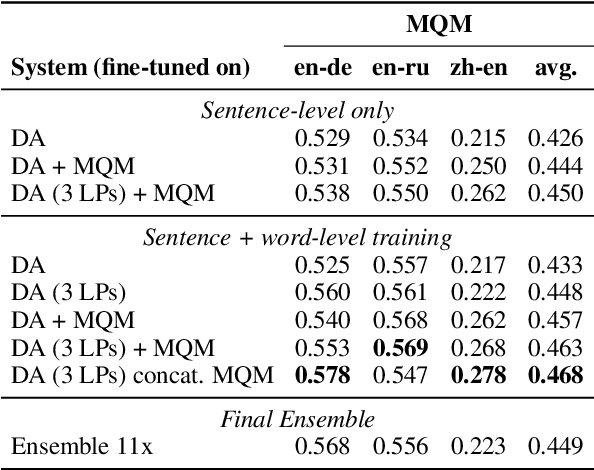
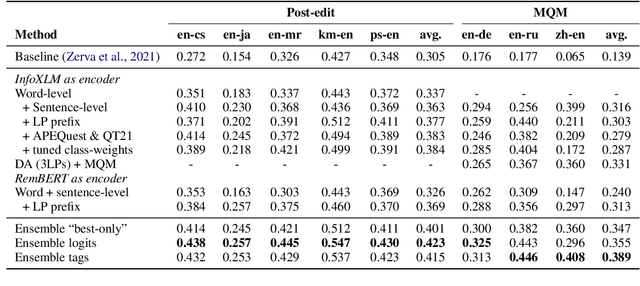
Abstract:We present the joint contribution of IST and Unbabel to the WMT 2022 Shared Task on Quality Estimation (QE). Our team participated on all three subtasks: (i) Sentence and Word-level Quality Prediction; (ii) Explainable QE; and (iii) Critical Error Detection. For all tasks we build on top of the COMET framework, connecting it with the predictor-estimator architecture of OpenKiwi, and equipping it with a word-level sequence tagger and an explanation extractor. Our results suggest that incorporating references during pretraining improves performance across several language pairs on downstream tasks, and that jointly training with sentence and word-level objectives yields a further boost. Furthermore, combining attention and gradient information proved to be the top strategy for extracting good explanations of sentence-level QE models. Overall, our submissions achieved the best results for all three tasks for almost all language pairs by a considerable margin.
 Add to Chrome
Add to Chrome Add to Firefox
Add to Firefox Add to Edge
Add to Edge